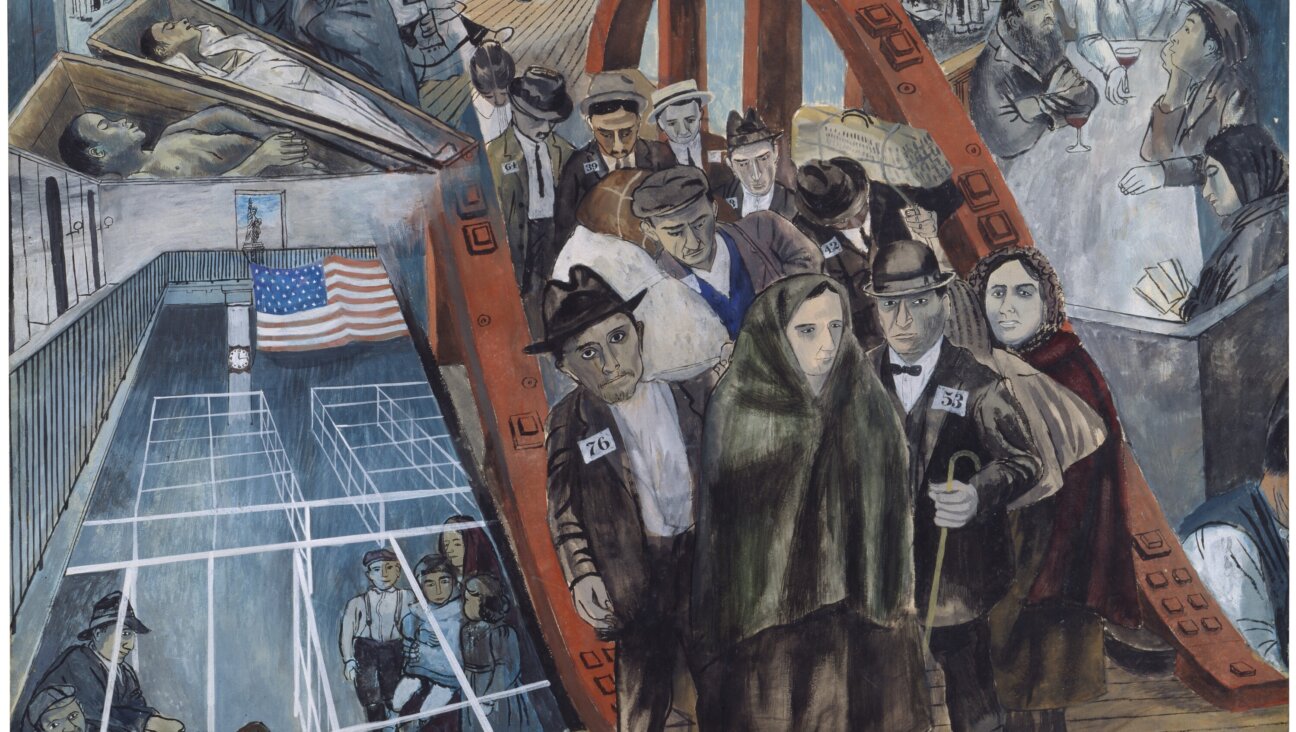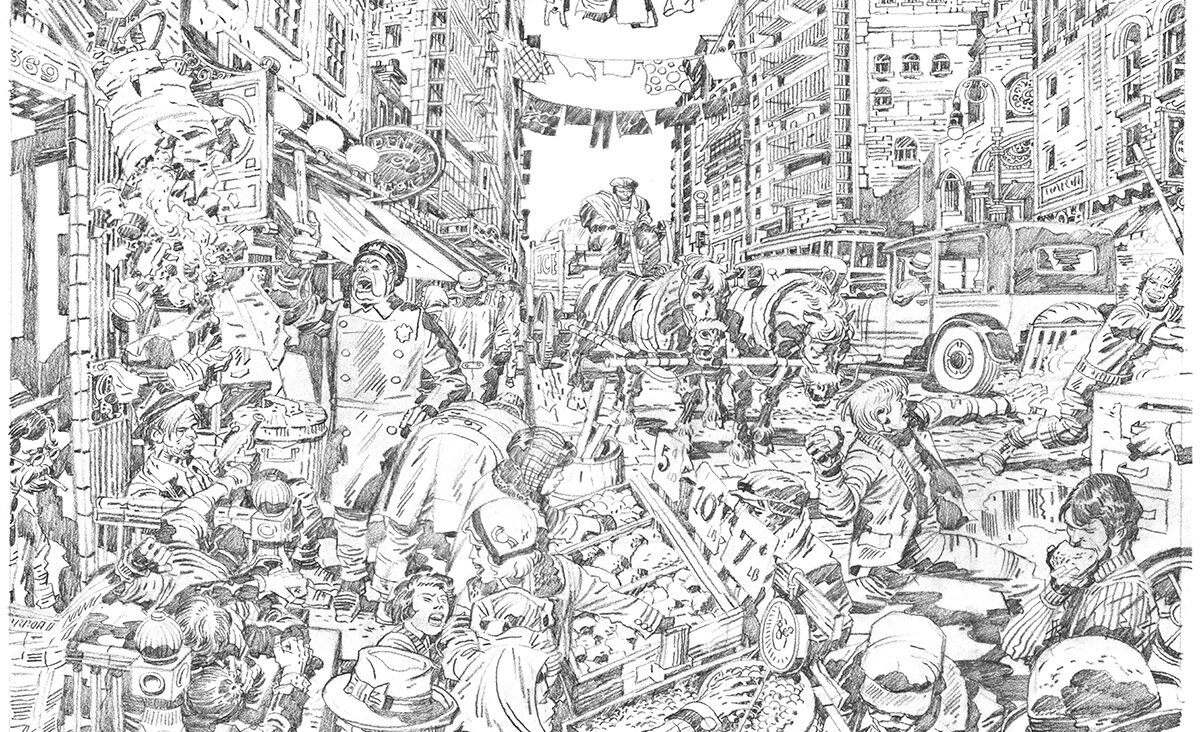Did Walter Benjamin understand his prize possession — Paul Klee’s Angelus Novus?

Graphic by Angelie Zaslavsky
Of all the icons to emerge from the left-wing politics of the last century, it is among the most talked about and the least looked at, the most mystical and the most frightening. It is probably the unlikeliest and also, by a country mile, the weirdest. Its caretakers make up the most exclusive club in 20th-century European philosophy. Since 1987 it has hung in the national museum of Israel, a country whose creation half of those caretakers applauded and the other half furiously opposed. By the time it was displayed to the public it had already inspired a few MLA conferences’ worth of dissertations, none of which rendered its meaning much clearer.
Strange that Paul Klee, of all artists, was responsible for a work that became a radical touchstone — stranger, still, that this work, of the thousands he completed, was the monoprint “Angelus Novus,” which celebrates its centennial this year. At a glance, almost everything about it screams “minor.” It’s tiny (31.8 by 24.2 cm) and features a relatively muted use of the oil transfer technique, with little of Klee’s usual synesthetic glitter (compare it, for example, to “Dance of the Moth,” a similarly sized oil transfer he finished a few years later). The “new angel” of the title is a pebble-toothed, big-eyed brute with wings like stubby old fingers and legs too feeble for its body. The drawing’s political ambitions seem to suit its aesthetic, which is another way of saying it’s typical of its maker. Klee, for all his aesthetic radicalism, was nobody’s idea of an engagé left-wing agitator — the critic Clement Greenberg may have been too harsh, but was still on the right track, when he called him “an eccentric but respectable bourgeois.”
The man who bought “Angelus Novus,” on the other hand, was an eccentric, proudly disrespectable bourgeois who remains, for many, the embodiment of political struggle. Walter Benjamin’s writings have left their enigmatic footprint on aesthetics, political theory and Jewish mysticism — it is entirely due to his attention that Klee’s angel today enjoys a prime place in all three fields. He bought the drawing in the spring of 1921 at a major show of the artist’s work organized by the Munich art dealer Hans Goltz; almost straight away, he seems to have decided that it was his prized possession. On July 15, his friend Gershom Scholem composed a poem for his birthday, written in the form of a soliloquy spoken by the angel. The poem ends, “I am an unsymbolic thing / and signify what I am / you turn the magic ring in vain / for I have no meaning.”
It was a claim Benjamin spent the rest of his life rejecting in increasingly ingenious ways. In his 1972 essay, “Walter Benjamin and His Angel,” Scholem suggests that the only thing his friend found more intellectually stimulating than the sight of Klee’s drawing was its absence. After Hitler’s election in 1932, Benjamin fled Germany for Spain; although he was forced to leave his beloved angel behind, it cameoed frequently in his writings from this period. In 1940, a few months before he tried and failed to enter Portugal, he finished his last major essay, “Theses on the Philosophy of History,” the ninth of which was a flight of the intellect fueled by nearly two decades of contemplating his print:
There is a painting by Klee called Angelus Novus. An angel is depicted there who looks as though he were about to distance himself from something which he is staring at. His eyes are opened wide, his mouth stands open and his wings are outstretched. The Angel of History must look just so. His face is turned towards the past. Where we see the appearance of a chain of events, he sees one single catastrophe, which unceasingly piles rubble on top of rubble and hurls it before his feet. He would like to pause for a moment so fair, to awaken the dead and to piece together what has been smashed. But a storm is blowing from Paradise, it has caught itself up in his wings and is so strong that the Angel can no longer close them. The storm drives him irresistibly into the future, to which his back is turned, while the rubble-heap before him grows sky-high. That which we call progress, is this storm.
Later that year, Benjamin was detained by Spanish police and informed that he would be deported to France, where, as a Jew, he was certain to be sent to a concentration camp. He died on September 26, 1940 — possibly by his own hand and possibly by Soviet agents who’d been ordered to dispose of the renegade leftist who had criticized the Hitler-Stalin pact.
In retrospect, it was fittingly unfitting that Benjamin’s body was buried in a Roman Catholic cemetery. Decades later, this lifelong student of Jewish mysticism is the closest thing to a saint in left-wing intellectual culture. Exiled and then martyred for his beliefs, he is now debated in classrooms with a zeal that masks an underlying dogmatism. What Benjamin meant by his ninth thesis is a topic of unceasing fascination, but his insistence that Klee’s drawing must depict the Angel of History is too rarely questioned in any serious way. This is especially striking, not only because Benjamin’s own interpretation of “Angelus Novus” changed many times but also because it’s quite possible that Klee intended for his drawing — the same drawing that has become a mascot of the Left — to be a caricature of Adolf Hitler.
The most famous sentence Benjamin ever wrote appears in his seventh thesis on the philosopher of history: “There has never been a document of culture, which is not simultaneously one of barbarism.” A powerful claim, and one that necessarily applies to the drawing that inspired Benjamin’s essay.
The longer great practitioners of the humanities live, the higher they tend to permit themselves to soar above hard, stubborn facts. Facts are their nourishment, and their greatest impediment. Facts must be bowed to, but not too deeply. In place of the facts, many great thinkers have offered personality — playfulness or religiosity or humbuggery. “Benjamin’s most amazing trait,” Scholem wrote, “was the connection between pronounced clairvoyance and the gift for dialectical subtlety on the one hand, but also the inclination to connect this clairvoyance with fantastic theories … in his later period he often stuck to them stiff-neckedly under the pretext of a purely heuristic procedure.”
Stiff-neckedly ¬— such a beautiful description of Benjamin’s prose. In “Theses on the Philosophy of History,” the tone is intense, sometimes overwhelmingly but never bullyingly — the intensity of Benjamin’s argument always seems to point back at his own mind, never the reader’s. Still, anyone who reads this essay for factual rigor is bound for disappointment — it’s telling that Benjamin’s interpretation of “Angelus Novus” had hardened into canon long before the public was in a position to see it for themselves. What he describes as a rubble-heap is just a byproduct of the oil transfer technique Klee used many dozens of times, never to represent debris. Even the name “Angelus Novus” contradicts Benjamin’s argument — in what sense could an angel of history be new? (It is also worth noting that Klee’s work is a drawing, not a painting; while the translation error is hardly Benjamin’s — the word he used was Bild — it suggests a puzzling carelessness among scholars vis-à-vis the artwork that inspired some of their hero’s best writing.)
These points might seem pedantic if you think that Benjamin’s essay isn’t really trying to be a close-reading of Klee’s work. Consider, however, the point on which the ninth thesis hangs: “The Angel of History must look just so.” An entire school of cultural criticism (including, perhaps, this very sentence) grew out of that stubborn, stiff-necked “must.” Eve Sedgwick would later call this the school of “paranoid reading”; the critic Jacob Mikanowski, writing in the Los Angeles Review of Books, described its practitioners as “obsessive exegetes whose criticism is willing to stake everything on the subject at hand.” Much of the power and swashbuckling romance of Benjamin’s analysis results from the disparity between the humbleness of its premises and the extravagance of its conclusions — the way he finds all of history compressed into a single tiny image. What get sacrificed at the altar of this kind of criticism are, inevitably, facts. In the ninth thesis, as in so many of Benjamin’s most daring passages, one feels that he is bending and suppressing aspects of a text in order to accommodate the theory he’s already deemed correct.
In the case of “Theses on the Philosophy of History,” Benjamin had to suppress some of his own readings of Klee’s drawing. In the 1930s, Scholem recalls, Benjamin smoked hashish and described the angel as a clawed, fanged demon. Exiled in Paris at the end of the decade, he began to write about the angel as a glum outcast. To ponder “Angelus Novus” was to glimpse, simultaneously, these interpretations and many others, not diluted but enriched by their ambiguity. To write about “Angelus Novus” was to assign it, at least temporarily, a single meaning and cast aside the others.
One of the most notable objections to Benjamin’s treatment of Klee came, perhaps unsurprisingly, from a scientist. Carl Djerassi may be the most fascinating character in the entire, century-long story of “Angelus Novus”: a Bulgarian-Jewish immigrant who settled in the United States in the 1930s; a chemistry professor at Stanford who collected Bauhaus art; a prolific researcher who found the time to write novels, poems, plays, and four memoirs. He also invented the oral contraceptive pill (no, really — he invented the pill). In September 2014, shortly before his death at the age of 91, he published a letter in the New York Review of Books in which he faulted Benjamin’s recent biographers for failing to note that Klee’s drawing was probably a caricature of Hitler. This had already been the conclusion of “‘Angelus Novus’: Paul Klee’s Picture and Walter Benjamin’s Interpretation,” J.K. Eberlein’s respected German-language study, as well as a point of no little importance in Djerassi’s experimental dialogue, “Four Jews in Parnassus.” How, Djerassi wondered, could the major English-language Benjamin biographies have missed such a bombshell?
I do not believe that it was a matter of sloppy research but rather that Benjaminologists assume that some of their hero’s most widely cited sayings such as the identification of “Angelus Novus” as the Angel of History are set in stone and should not be questioned. They ignore that not all of the stone is granite, but may in fact be crumbling.
A certain righteous indignation animates Djerassi’s letter, the same indignation I sometimes get from my comp sci friends when I try to tell them about simulacra or negative dialectics. Walter Benjamin already gave his unprovable interpretation of Klee, the great chemist seems to say, so why the hell shouldn’t I give mine? And mine will be based on facts!
The facts, then. In 1920, Hitler was a minor painter but an increasingly major orator. After February 24, when he delivered the speech that marked the birth of Nazism, he became instantly recognizable to tens of thousands in Munich. Even at this early stage he was shrewd about Fascist iconography — his trademark uniform was the trench coat he’d worn during his years in the Bavarian Army in World War I. Klee, who’d lived in Munich since 1906, had served in the Bavarian Army, too. There is precedent, furthermore, for notable artists — even those who weren’t in the same army — drawing Hitler well before he was internationally known. Otto Dix’s 1923 “Pimp and Girl” is as unmistakable a portrait of the Führer as there has ever been, never mind that he wouldn’t become Führer for another nine years. (Even in 1923 people were making fun of Hitler’s haircut: one journalist likened it to a pimp’s, and Dix simply took the joke a step further.)
You don’t need to agree with Djerassi to see the value of his analysis. Rummaging through the historical record, he brings out some of Klee’s qualities that Benjamin ignores — his earthy, sardonic streak, his suspicion of grand theses (excepting, of course, Klee’s own). Titling the work “Angelus” rather than “Angel,” Djerassi suggests, may have been a kind of bathetic pun that pointed back to the original Greek word angelos, “messenger.” Viewed this way, the angel is a false prophet, not a divine being but a grubby opportunist trying to fluff itself into importance, always angling for another follower. The year after, it bears mentioning, Klee completed a similar oil transfer print; like “Angelus Novus,” it features a grinning, short-limbed creature, who dangles a hook down into the abyss. Klee named the creature “Der Angler,” “The Angler” — a title that, paired with that of his earlier, better-known drawing, sounds like a pun on a pun: “angel” stripped of a further layer of enchantment.
The piece of evidence that clinches Djerassi’s theory, at least for me, arrived a decade later. Shortly before Benjamin fled Germany, Klee drew an unambiguous caricature of Hitler. He gave his subject black little claws for hands and an ostentatious suit with big tassels on the shoulders —tassels whose resemblance to a pair of wings is clear, eerie, and perhaps eerily familiar.
Hitler, Stalin, Scholem, Israel, mysticism, science, art, philosophy, radicalism, liberalism, caricature — a vast wreckage has swept “Angelus Novus” into the 21st century. None of the pieces fit together, even as they’re united by their connection to Klee’s drawing. Some are bigger than others; some grow or shrink depending on which languages you happen to understand. In Germany, for instance, Angelus Novus’s connection to Hitler has been mainstream (at least as mainstream as a century-old drawing’s backstory can be) since 2008, the year curators at the Neue National Galerie in Berlin pushed this interpretation as part of their massive Klee exhibition.
If, tomorrow, an English-language book about “Angelus Novus” and Hitler were published and became a surprise best-seller, it would do nothing to diminish Benjamin’s reputation or refute his theories — the Angel of History is still the Angel of History, whether or not Benjamin is right about Klee. From here, it would be easy to go a step further and conclude that the historical inspiration for “Angelus Novus” is basically irrelevant to the “Theses on the Philosophy of History,” or at best a scrap of trivia for Benjamin completists to gnaw on.
Tempting, but also wrong. If challenged to name a piece of writing that sums up why the prehistory of “Angelus Novus” isn’t just relevant but essential to the study of Walter Benjamin, I think I’d choose Benjamin’s own “The Task of the Translator,” completed two years after he’d acquired Klee’s drawing. Benjamin begins by questioning one of the most basic assumptions about translators: that their job is to rip the meaning out of a piece of writing and graft it smoothly onto another language. Instead, the translator must aim to produce a work whose “meaning” lies somewhere between two languages, suggesting something of both languages’ textures and tones and idiosyncrasies. There is no perfect way of doing this, because languages are always changing, and so translation must always be fragmentary, an unwinnable struggle. At its best, however, translation is like poetry. It offers a glimpse of “that pure language which is exiled among alien tongues,” a mystical, Edenic language from which all other languages and all possible meanings are descended.
The struggle for meaning is one of Benjamin’s great subjects, apparent not only in the content of his sentences but in the meticulous tangle of their phrasing. It’s strange, then, that with Benjamin’s intellectual canonization his big ideas — the aura of the work of art, the urban flâneur, the Angel of History — have been severed from the living, breathing exertions of their arguments and drowned in the formaldehyde of academia. Djerassi’s theories matter, then, not because they decode “Angelus Novus” but because they re-code this work, allowing us to wrestle with it anew and see it as Benjamin did: a pantheon of meanings in which angel, demon, wanderer, servant, and tyrant coexist like the white vase and black profiles of the famous optical illusion. And when we approach Klee’s drawing in this way, we may also see a version of the Eden Benjamin described in “The Task of the Translator” — the image in its full, uncodified strangeness, the shock of that pure image which is exiled among alien interpretations.
No great conclusions or takeaways, then — just an exhortation to follow Benjamin in spirit, not letter. It’s a cliché that the value of great thinkers lies in their showing us how to think, not what to think, and that cliché is especially true of Benjamin. Late in life, when he’d attracted a thousand overeager disciples, Marx complained, “even I am not a Marxist”; by the same token, if Benjamin were alive today he could never be a Benjaminologist. Better for contemporary readers to forget the Angel of History for a moment, return to the artwork that inspired it, and form their own unique constellation of then and now. And when we do so, it should perhaps come as no surprise that we’d find an angler instead of an angel — a nasty little demagogue desperate for ears.























